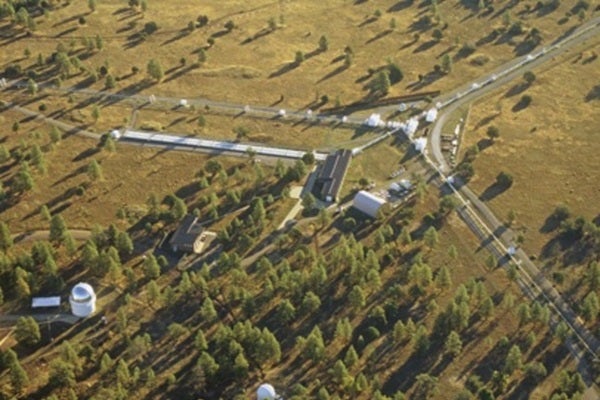Astronomy’s contributions to society have only grown more important in the thousands of years since then. The digital camera in your DSLR and smartphone — the devices fueling the rise of social media — likely wouldn’t be what they are today without decades spent by astronomers pushing their limits. Wi-fi was invented by an astronomer trying to sharpen images from his telescope. Even our ideas about the future of Earth were shaped by astronomers’ observations of the runaway global greenhouse effect on Venus — and what it meant for climate change on our own planet.
Here are four surprising ways astronomers have reshaped our modern world. So the next time someone asks what studying space is good for, you’ll have a snappy response.
The star charts that direct modern life
For more than two decades, an astronomical observatory shaped like a 1,400-foot Y has sprawled across Anderson Mesa in northern Arizona. This instrument, owned by the military and run by astronomers at both the U.S. Naval Observatory and Lowell Observatory, is the biggest telescope of its kind.
Unlocking the power of the Sun
With war on the horizon across Europe, the applications beyond astronomy quickly became obvious. During the Manhattan Project, Bethe was even appointed to lead the theoretical group at Los Alamos, where he worked on the first nuclear bombs. (He later spoke out against the weapons.) Bethe’s work also helped scientists develop nuclear power, which is achieved through fission instead of fusion. There are now hundreds of nuclear power plants around the world.
The development of radar
Around the time Bethe was unraveling the secrets of our Sun, researchers around the world were developing and deploying the first radar instruments to study Earth’s ionosphere. This region is where incoming solar and cosmic radiation ionize our planet’s atmosphere, knocking away electrons from the atoms there.
As Britain grew increasingly concerned about German air raids, the country’s defense department asked radio physicist Robert Watson-Watt about employing the technology as a kind of death ray to down enemy planes. Instead, the scientist suggested radar could be used to track approaching aircraft; as World War II erupted, radar technology became pivotal on land, in the air, and at sea. Radar’s uses now extend far beyond the military. Without it, forecasters wouldn’t be able to watch approaching weather and spot regions of concern, such as forming tornadoes.
The invention of memory foam
As mattress companies like to remind us, the average human will spend about one-third of their life asleep. If you’re regularly getting a good night’s sleep, you might need to thank NASA. During the Apollo program, Charles Yost, an engineer at North American Aviation Inc., was tapped to work on absorption technology for the command module that carried astronauts to the Moon.
Then, just a few years later, NASA enlisted that experience again. This time, he was assigned to help build safer, more comfortable airline seats for airplanes flown by NASA’s Ames Research Center. According to NASA, “Yost created an open-cell, polymeric ‘memory’ foam material with unusual viscoelastic properties; that is, it possessed both high-energy absorption and soft characteristics.”
The new foam offered more protection if there was a plane crash — and it was also more comfortable on long flights. They called it “slow springback foam.” Yost spun the tech off into the private sector, where upgraded versions are still used in everything from football helmets to motorcycle seats to clothing and, yes, mattresses.











